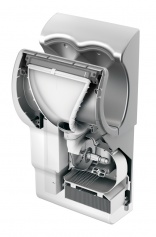Home › magazine › special features › Pushing boundaries in dryer engineering
Pushing boundaries in dryer engineering
26th of November 2012Have you ever wondered where the ideas for new products come from? Or how they are designed, engineered, prototyped and launched as finished articles? ECJ editor Michelle Marshall visited Dyson, the company that launched the groundbreaking Airblade hand dryer, to talk exclusively to its design manager about how the product came about.
When it was launched in 2006 the Dyson Airblade caused a real stir in the world of hand dryers. Its appearance was modern and exciting, it worked in a radically different way to traditional models and for the user it was a brand new experience.
Behind the Airblade’s groundbreaking design was a team of engineers at Dyson in the UK, a company previously best known in the consumer business for its innovative vacuum cleaner technology. Marcus Hartley is the design manager for the Airblade – he has been with Dyson for eight years and the hand dryer was the first project he worked on. He explained how the idea first came about.
“We had some good existing technology on the shelf in our DDM, the Dyson Digital Motor,” he said. “We generally try to find the best uses for our technology and up until then this motor had been used mainly in our floor care products. However the fact it is very small, hygienic, runs at a massive speed and has significant blowing force makes it ideal for hand drying.”
In those early stages of development the Dyson engineers also investigated how to remove water from surfaces, including hands, at high speeds. “In our experience many of the existing options on the market were poor,” Hartley points out.
“So our brief was to design a machine that dries hands, is completely hygienic and energy efficient. And very importantly, it had to have a clear benefit over the competition – that is a key requirement of any new product introduced by Dyson.”
So once the team had decided what product it wanted to design, it set about carrying out a programme of research. The engineers worked with many hand hygiene experts, for example, in the quest to determine exactly what is a dry hand. “That was our biggest challenge,” Hartley goes on, “understanding how to dry hands. There is no acknowledged standard so we had to develop our own methods of testing.
“Our research led us to conclude that to achieve a dry hand, men will usually wait for 13-14 seconds, whereas women will wait for only 10-11 seconds. So we were aiming for a 10-second dry with our new dryer. Hand dryers had not changed in decades so we very much wanted to drive the technology forward.”
Various disciplines
Designing a product like the Airblade involved using expertise from a number of engineering disciplines. The design engineers did the drawing and initial testing of the key elements; the motors engineers took care of the motor; electronics engineers worked to ensure the Airblade could be touch-free; fluid engineers made sure the airflow was correct; test engineers checked for endurance; and the acoustical engineering team established the machine made the right tones.
So having established the design of the new hand dryer, the Dyson team began to make prototypes. The company has its own in-house facilities to construct prototypes using SLS (Selective Laser Sintering) rapid prototyping. Three-dimensional parts are created by fusing (or sintering) powdered thermoplastic materials with the heat from an infrared laser beam.
The object’s creation is accomplished by repeatedly fusing thin powder layers using a laser beam. This additive manufacturing sequence produces parts that gradually increase in size until they reach the prescribed dimensions. These prototypes are created directly from 3D CAD models.
“The first Airblade prototype looked completely different from the finished product,” says Hartley.
“We usually factor in a 24-month cycle from the point when we determine what we want to produce to the market launch. It actually took three years to develop the first Airblade and the motor took five years.” The motor team worked on that separately and it has dual use in one of the vacuum cleaners.
Throughout the process regular reviews are carried out. “Every three to four months we reach what we call a ‘milestone’ which gives us sign-off for more resource to take the project forward,” Hartley continues. “In the first stages of the Airblade’s design only the engineers and the founder/owner James Dyson knew about it – it was top secret. Dyson himself was making all the decisions about resourcing the project as it went forward because there were concerns about IP so he wanted to keep all information within a tight team.”
After 12 months between 50 and 60 prototypes had been made and the engineering team was convinced by then that the Airblade was a viable product. Hartley explains the next stages. “We were being truly challenged by the motor. The Dyson motor is one of the first to be truly brushless and it runs at 90,000 rpm, which is 10-15 times faster than a car. It’s also producing hundreds of G-forces, which presents various technical challenges in that there is a real explosion risk.
“This meant we had to select the materials for parts extremely carefully. We finally settled on PEEK (Polyetheretherketone), a high-temperature plastic with outstanding mechanical properties. At that time it was only being used by Formula One and the United States Air Force - so a highly specialised material.
“That was a big moment for the team, when we overcame that particular obstacle. We could have used an alternative material but that would have meant compromise on performance and speed – for us that was not an option because we had such exacting expectations for the Airblade.”
As with the design of any new product, the engineering team can often feel as if it’s taking one step forward, then five steps back. At Dyson it was no different with the Airblade. “Our motor technology is our biggest challenge and our biggest success,” Hartley explains. “Motor development is key to our business and we make all our own. The philosophy is that if we own every part used in our products, they are more difficult to copy.”
Airblade structure
The distinctive appearance of the Airblade is now a familiar sight in public washrooms around the world, but why does it look the way it does and how is its appearance vital to its operation?
At the bottom of the casing there is an air inlet, then a HEPA filter – air flows through at 37 litres per second. The air goes over the electronic components of the Airblade to keep them cool, and it is massively compressed so it exits extremely fast and very hot. Acoustic modifications help to silence the motor and keep the noise level as low as possible.
Air then travels into the expansion cavity then the duct. This directs airflow to what’s known as the ‘knife’ – the thin blade of air that actually dries the hands. The air is straightened within the duct so that when it hits the knife it is essentially a sheet. It’s then ejected from a slot just 0.3 mm wide.
The size of that slot was another significant challenge for the design team, Hartley explains. “The size of it was determined by acoustics and the drying time. However it took us four months to understand how to make that gap because we had to find a material that was stable when moulded and fitted all aspects of our specification.
“Again we sourced a special material, a Bulk Moulding Compound (BMC).” Injection moulding of BMC is used to produce complex components such as electrical equipment and housings for electrical appliances.
Dyson is renowned for the distinctive design element of all its products – so are aesthetics and appearance the primary consideration when developing something new? As Hartley explains, it’s very much the opposite. “It’s the function and workings of any machine that drives our development, not the design,” he emphasises.
First for commercial market
“With the Airblade that wasn’t any different. Every aspect of the shape and form is the way it is because of what’s inside the casing. Above all the casing has been designed to be tough and durable – very much an engineering-driven decision.”
The Airblade was actually the first product Dyson had designed for use in the commercial market, an entirely new experience for the engineering team. In fact an entirely new division was set up for it. “For the first time we had to take into consideration that one of our products was going to be used in high-traffic washrooms where it would encounter heavy use, and perhaps even abuse,” explains Hartley. “That meant design for robustness and long life was paramount. For example the ABS plastic used in the casing is the same as that used in riot shields.”
The Airblade was also subject to water ingress tests under the IP Code (Ingress Protection Rating). Products are rated as to the degree of protection provided against the intrusion of solid objects (including body parts like hands and fingers), dust, accidental contact and water in mechanical casing and with electrical enclosures.
Hartley explained that the Airblade has achieved IPX level five liquid ingress protection. “This means it is basically waterproof and has reached the appropriate standard for an electrical appliance that is sited in a washroom.”
The smoothly designed seals on the Airblade casing were incorporated to ensure there are no crevices or cracks where bacteria and dirt could build up. “This helped us with HACCP rating.”
With the prototyping finished, the testing of the Airblade started. Most of that work was carried out in-house, again because Dyson was keen to keep the project top secret until the launch. The test engineers ran the machine for 24 hours a day and struck it hard for very long periods to simulate abuse it may encounter in away-from-home washrooms. The team also created some models of the hands of ‘Mr Average’ based on measurements taken from all the staff on the Dyson UK site. This enabled 24 hour testing of the actual drying process.
“This testing continually brought up other issues to be tackled,” continues Hartley. “Development goes on at all points of the process, even this late stage. For example, we found out more about how the properties of the casing material changed with abuse, use of cleaning chemicals etc.”
There must come a point when the design phase ends, when the engineering team is content that the product is ready to be introduced to the market. For Dyson, that meant Airblade left the UK headquarters and was transferred to the company’s factory in Malaysia in order to be put into
full production.
“This presented a whole new set of challenges,” says Hartley. “Because making prototypes is fairly simple compared to taking an entirely new machine into mass production. There may have been small adjustments to the Airblade at that stage but essentially design stopped when it left the UK site.”
Motors for the Airblade are produced in Singapore while Malaysia is home to injection moulding and assembling of the hand dryer.
As we all now know, the launch of Airblade was a resounding success – this was a product that really prompted the market to look at hand dryers in an entirely new way. And it currently has over 60 patents or patents pending for the current model.
For Marcus Hartley and his team, however, it does not stop there. As soon as the first Airblade was launched, they were looking ahead. There’s more to come from Airblade, he says, but of course for the moment it’s all top secret. So watch this space!









